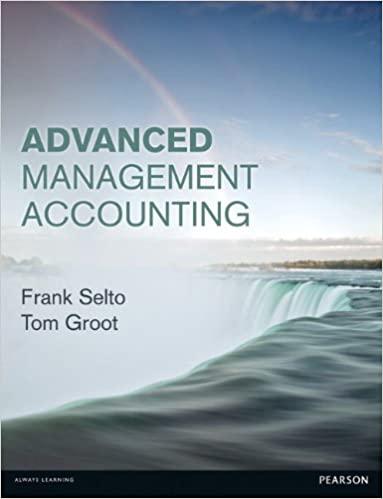Question
Schedules of Expected Cash Collections and Disbursements; Income Statement; Balance Sheet [LO8-2, LO8-4, LO8-9, LO8-10] Skip to question [The following information applies to the questions
Schedules of Expected Cash Collections and Disbursements; Income Statement; Balance Sheet [LO8-2, LO8-4, LO8-9, LO8-10] Skip to question [The following information applies to the questions displayed below.] Beech Corporation is a merchandising company that is preparing a master budget for the third quarter of the calendar year. The companys balance sheet as of June 30th is shown below: Beech Corporation Balance Sheet June 30 Assets Cash $ 84,000 Accounts receivable 144,000 Inventory 63,750 Plant and equipment, net of depreciation 223,000 Total assets $ 514,750 Liabilities and Stockholders Equity Accounts payable $ 84,000 Common stock 349,000 Retained earnings 81,750 Total liabilities and stockholders equity $ 514,750 Exercise 8-12 (Algo) Beechs managers have made the following additional assumptions and estimates: Estimated sales for July, August, September, and October will be $340,000, $360,000, $350,000, and $370,000, respectively. All sales are on credit and all credit sales are collected. Each months credit sales are collected 35% in the month of sale and 65% in the month following the sale. All of the accounts receivable at June 30 will be collected in July. Each months ending inventory must equal 25% of the cost of next months sales. The cost of goods sold is 75% of sales. The company pays for 40% of its merchandise purchases in the month of the purchase and the remaining 60% in the month following the purchase. All of the accounts payable at June 30 will be paid in July. Monthly selling and administrative expenses are always $44,000. Each month $6,000 of this total amount is depreciation expense and the remaining $38,000 relates to expenses that are paid in the month they are incurred. The company does not plan to borrow money or pay or declare dividends during the quarter ended September 30. The company does not plan to issue any common stock or repurchase its own stock during the quarter ended September 30. Required: 1. Prepare a schedule of expected cash collections for July, August, and September. 2-a. Prepare a merchandise purchases budget for July, August, and September. Also compute total merchandise purchases for the quarter ended September 30. 2-b. Prepare a schedule of expected cash disbursements for merchandise purchases for July, August, and September. 3. Prepare an income statement that computes net operating income for the quarter ended September 30. 4. Prepare a balance sheet as of September 30.
Schedules of Expected Cash Collections and Disbursements; Income Statement; Balance Sheet [LO8-2, LO8-4, LO8-9, LO8-10]
Skip to question
[The following information applies to the questions displayed below.]
Beech Corporation is a merchandising company that is preparing a master budget for the third quarter of the calendar year. The companys balance sheet as of June 30th is shown below:
| Beech Corporation | |
| Balance Sheet | |
| June 30 | |
| Assets | |
|---|---|
| Cash | $ 84,000 |
| Accounts receivable | 144,000 |
| Inventory | 63,750 |
| Plant and equipment, net of depreciation | 223,000 |
| Total assets | $ 514,750 |
| Liabilities and Stockholders Equity | |
| Accounts payable | $ 84,000 |
| Common stock | 349,000 |
| Retained earnings | 81,750 |
| Total liabilities and stockholders equity | $ 514,750 |
Exercise 8-12 (Algo)
Beechs managers have made the following additional assumptions and estimates:
-
Estimated sales for July, August, September, and October will be $340,000, $360,000, $350,000, and $370,000, respectively.
-
All sales are on credit and all credit sales are collected. Each months credit sales are collected 35% in the month of sale and 65% in the month following the sale. All of the accounts receivable at June 30 will be collected in July.
-
Each months ending inventory must equal 25% of the cost of next months sales. The cost of goods sold is 75% of sales. The company pays for 40% of its merchandise purchases in the month of the purchase and the remaining 60% in the month following the purchase. All of the accounts payable at June 30 will be paid in July.
-
Monthly selling and administrative expenses are always $44,000. Each month $6,000 of this total amount is depreciation expense and the remaining $38,000 relates to expenses that are paid in the month they are incurred.
-
The company does not plan to borrow money or pay or declare dividends during the quarter ended September 30. The company does not plan to issue any common stock or repurchase its own stock during the quarter ended September 30.
Required:
1. Prepare a schedule of expected cash collections for July, August, and September.
2-a. Prepare a merchandise purchases budget for July, August, and September. Also compute total merchandise purchases for the quarter ended September 30.
2-b. Prepare a schedule of expected cash disbursements for merchandise purchases for July, August, and September.
3. Prepare an income statement that computes net operating income for the quarter ended September 30.
4. Prepare a balance sheet as of September 30.
Step by Step Solution
There are 3 Steps involved in it
Step: 1

Get Instant Access to Expert-Tailored Solutions
See step-by-step solutions with expert insights and AI powered tools for academic success
Step: 2

Step: 3

Ace Your Homework with AI
Get the answers you need in no time with our AI-driven, step-by-step assistance
Get Started


